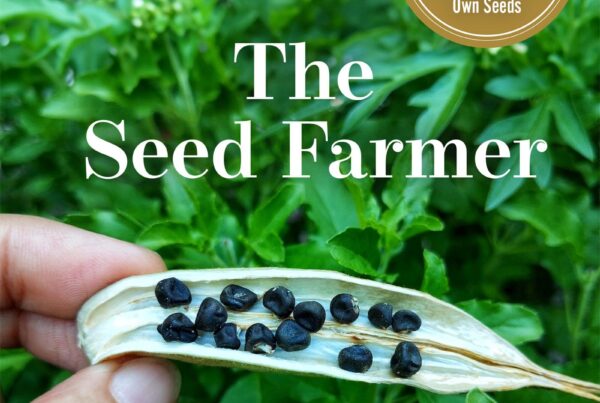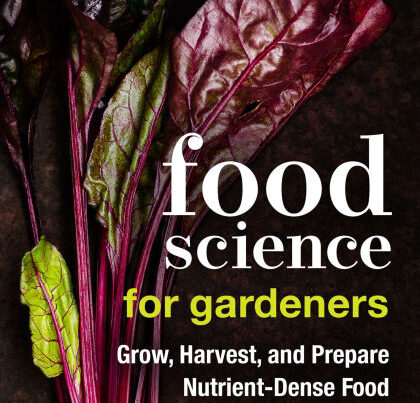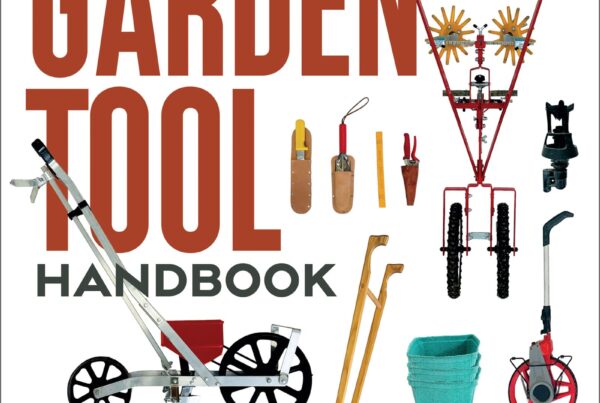Reviewed by Pam Dawling
Ben Hartman, Chelsea Green, August 2015. ISBN 978-1-60358-592-7. $29.95
When I heard of this book, I immediately wanted to read it, sensed that I needed to read it, that our farm would benefit from exploring the ideas in it. At the same time, I felt some awkwardness: I might be tempted to hide this book from some of my crew, because gardening is something they’ve chosen because it’s in some ways opposite to factory work. If I introduced some of these ideas would I be seen as trying to make our farm more like a factory? It is unfortunate for simplistic thinking that the lean system ideas came from car manufacturing. As Ben Hartman says, “In some circles, to pair the terms ‘factory’ and ‘farm’ is sacrilege.” Factory farming causes many problems. And yet we should not dismiss the ideas because of this connection. That would be a knee-jerk prejudice. The ideas have value that is useful for other occupations, including farming. Farmers work hard, and we can use good ideas on how to reduce wasted effort so that we can be less stressed, more successful at producing food and happier, with more satisfying lives. And yet, both factories and farms are places of production.
Factory work uses inert consistent raw materials. In farming the raw materials are unpredictable, variable, liable to change. Farmers need to adapt their plans to the situation on the ground.
It’s not even really accurate to say that farmers grow food or raise animals. Farmers adjust environmental conditions as far as they are able, to maximize a plant’s or an animal’s chance of making its own growth.
The Lean System is not geared to taking the fun out of farming. It is geared to make farms more pleasant places to work, places where we can do better work, and leaving us time for other pursuits. Lean is just a tool – you keep you core values. In fact you focus on them more centrally, in addition to respecting your workers. Ben Hartman describes their early days as farmers, working endless days, and gives his reasons for trying the lean system. “Our production . . . was erratic: every week we seemed to seesaw between over-producing and under-producing. We had a sense that if our farm was to survive for the long haul, the chaos would need to settle down.”
Taiichi Ohno, the author of inspiring short books in English on the Lean system describes the method as “looking at the timeline from the moment the customer gives us an order to the point when we collect the cash. And we are reducing that timeline by removing the non-value-added wastes.”
The book explains the five principles of Lean:
- Precisely specify what the customers value (not just the products, but also the presentation, timing, and packaging or not).
- Identify the value stream for each product (the steps in the process that create value).
- Make value flow without interruption (remove waste).
- Let the customer pull value from the producer (don’t over-produce and dump/push).
- Pursue perfection (continuous improvement).
- Yes, he said 5. Respect the workers (harness the collective wisdom).
One place to start reducing waste is to physically clean up the farm. There are five tools with Japanese names beginning with S (the 5S tools). Translated and keeping the S theme, they are Sort, Set in order, Shine, Standardize, Sustain. The idea is to cast off the physical junk and waste that weighs down the farm. This reminded me of the domestic “Japanese tidying” craze that has got several of my friends. You get rid of anything that doesn’t bring you joy. The premise is that there is a cost to keeping and storing things. If you get rid of the things you don’t use, and store the useful stuff well, it will be quick and easy to find what you need. You can start with a Red Tag room where you put things no one uses. Once a year you send the unused things on their way. “Shine” means clean well-lit uncluttered spaces. “Standardize” means not just less confusion, but also having a designated result of daily cleaning and restoring order, with a posted photo showing what the area should look like when clean-up is finished. I can really see where one picture can be much more effective than a check-list of a thousand words. The Sustain part is about improving the work environment so that everyone feels good working there, happily absorbed in their task without distraction.
It is important to identify what your customers value. Sometimes Steve Jobs is right and people don’t know what they want till you show them, but often it’s not true. The important bit is not what you think they ought to value, but what they actually value. Observe, ask. Find out which of your activities add value and which add waste. There are four kinds of distraction:
- Technology fascination, gadgets. Beware of unhelpful complexity.
- Product fascination: weird and wonderful shapes and colors of vegetables.
- Process fascination: unusual methods of growing crops.
- Letting supply determine value. More kale is not always better!
Customers usually value a mix of goods and services such as presentation or reliable deliveries. You can add a small percentage of surprises, but not too many.
Learn to see value and distinguish the tasks that create actual value from the tasks that don’t (wasted movements, waiting time). It may help to write out all the steps of a task in a list and consider the value or wastefulness of each.
There are two main types of waste. Type 1 is tasks that are necessary but do not add actual value. Type 2 waste is pure waste that achieves nothing. This part of the book was very challenging for me. I feel a bit insulted, disregarded when necessary work is called wasteful. I don’t think this classification is helpful, especially as it includes a lot of managerial tasks like planning. I do understand that the value of the final product is not directly related to the time spent planning, and that it’s good to keep a check on overhead hours and not let them expand beyond usefulness. Is reading this book type 1 waste? But the author says eliminating the type 2 pure waste is not enough. Type 1 is more pernicious. It’s only the last turn of the nut on a bolt that tightens it – the other turns are “just movement”. Only planting the seeds, harvesting the crop, washing, packaging and display add value. Thinning, weeding and bed prep do not. “Tending the plants might be the fun part of farming but it does not create value.” Hmmm. I don’t find this bit helpful. I disagree with this outlook. I get it that it’s best to farm so that tasks such as soil preparation, plant support, pruning, weed management are minimized. Hand weeding, especially, is a sign of earlier failures, a task to strive to not need to do. But if it’s needed, it must be done! The truth I can see in this approach is that planting and harvesting are the top priority tasks. We’ve long used the mantra “Prioritize planting in the planting season” and here most of the year is the planting season for something. I still don’t like calling weed management wasted time! It’s less wasteful than not dealing with the weeds.
Within the two main types of waste there are ten categories of waste:
- Overproduction (poor forecasting, surprise weather, market volatility)
- Waiting (people waiting or products waiting, needing storage)
- Transportation (inefficient use of vehicles and time)
- Overprocessing (bagging when not needed; too much time on fancy websites)
- Inventory too high
- Wasted motion (poor farm layout, poor task planning)
- Too many culls before or after storage
- Overburdening people or tools, leading to injury and poor work
- Uneven production and sales (lost rhythm, more mistakes)
- Unused talent (look to all workers for ideas for improvements)
The goal is to banish waste to increase efficiency. This can involve counter-intuitive thinking and plain hard work. There are 9 tools to root out waste:
- Minimize moves (efficient layout of packing sheds, storage of tools etc. Use both hands fully, and add as much value as possible to the item in your hand before setting it down). “Single piece flow” is much faster than “batch and queue” even if that is counterintuitive.
- Lighten the load. Don’t use unnecessarily heavy tools or containers.
- Don’t overdo, over-package, over-clean
- Ask Why? five times to get to the root cause of a problem and find something you can improve.
- Employ mistake-proofing. Everyone is responsible for preventing mistakes. Have two different people check on important things. Each person exercises quality control on the steps that went before.
- Shorten cycle time: choose faster-maturing varieties, use optimal germination temperatures, use transplants to get earlier crops, find processes to speed growth (heating to 30F in winter double the plant growth compared to an unheated greenhouse), cut out unnecessary steps.
- Choose technology with a human touch: the machine should serve the workers and not vice versa. Choose flexible machinery that does not introduce more waste or require complex training.
- Order supplies just in time
- Benefit from the expertise of others: get skilled tasks done by people with those skills.
Hartman says: “We did not want to add hours to our workload. . . But we wanted to make our work easier . . . after we leaned up our production. . . we saw an incredible difference. We were working less and our food quality was increasing . . . we wondered if lean had management tools.” Waste in management occurs in the planning stages: choosing the wrong crops, bogging down your farm with experiments, producing too much of something. Farm management is considered so wasteful that there are seven tools for rooting out management waste:
- Practice production control (stop hoarding). Get better at estimating yields, predicting the weather, planting and harvesting only what will be needed. Don’t overproduce to compensate for lost opportunities in the past – lost opportunities are an emotional loss but not a physical loss. Actual losses result in actual harm. [Hmm – isn’t loss of income an actual harm?] Make value-added products with surpluses – don’t dump excess produce on the market as it is.
- Cut costs to grow profit margins. Decreasing costs by $x increases profits by $x. Cost savings will continue to benefit you in the future. Try to reduce wasteful costs by 5% per year. Increasing sales by $x does not increase profits by $x, because of extra costs. It also adds extra work and stress.
- Replace low-profit items with high-profit items. “What would happen if we stopped growing our three or four poorest-performing crops?
- Maximize production while keeping fixed costs the same. Don’t expand equipment or infrastructure until you are at full capacity using what you’ve got.
- Level the load. Look at the workload and sales over the year and try to even it out to reduce stress and wasted time. [But by all means plan a vacation!]
- Look at measurable aspects of your work to assess progress. Examples include the dollar value per (standard) container, yield per square foot, labor per unit, machinery-hours per unit for various crops. Keep goals measurable and attainable.
- Balance creativity and discipline: too much creativity can cost you too much. 15% of time or space on experimental projects is enough! The rest of your resources should go on known paths to success.
“Pull selling” is replenishment – when the customers need more, provide more. This is more efficient than having large amounts and no idea who wants it. Not always easy when you are selling a product that takes 40 days, 60 days or more to produce. Hartman recommends not to set prices by adding profit (=wages for you) to costs, but instead to agree a price with your customer. The customer doesn’t care what your costs are. Charge what you can, then take responsibility for your costs yourself. If it doesn’t pay to sell that crop, stop growing it. If your customers value red tomatoes more than heirlooms, change the ratio of what you grow. Don’t be tied to growing heirlooms if you struggle to make enough money from them.
Continuous improvement (Kaizen) involves looking at each of the steps in providing a crop and listing them as of value or waste, then focusing on reducing waste. All workers can contribute their insight. There are 5 tips:
- Develop regular improvement routines. Have clipboards where everyone can leave comments. Have meetings to review recent events and develop new ideas.
- Focus on the 3 or 4 most-needed improvements. Set priorities, take logical steps.
- Upgrade standards often, as you find improvements. Take a leaf rake over the salad mix after each cutting.
- Compare your farm to your farm – don’t recreate someone else’s farm.
- Don’t wait for things to go wrong – it’s harder to improve things during a crisis.
Respecting the workers goes hand-in-hand with continuous improvement. You need well-trained, well-treated staff. There are 3 tools to help achieve continuous improvement in workers:
- Training on the job. Train yourself first, test out every task before training others on it. Break the job into steps and write them in short sentences on training sheets.
- Standard Operating Procedures – instruction sheets with pictures showing how you (as a group of workers) want the job done.
- Visual Systems Management – Color-coded task management boards to distinguish To Do from Done
Supervise the work, not the workers. Assess by the value produced, not the speed the hands are moving at.
This is a very thought-provoking book. I found I was constantly assessing our farm as I read this book: “ah, we already do that (well)” “oh we really need to do that” “ooo I’m not happy with that idea”
Another part of the book gives examples from their farm, to show how these ideas have been useful. Here are some examples:
- They shifted to all 30” beds, bought a smaller tractor with the appropriate rear tire spacing and narrow tires, along with a bed shaper. This left very little hand work for prepping beds. Clay Bottom Farm has 50 hoophouse beds and 56 outdoor beds, 30” x 90’ mostly. Also 5 plots of annual vegetables 30’ x 60’ and various perennials.
- They built a 6’ x 14’ box shaped mini-greenhouse (with heating) inside one of their heated high tunnels for their earliest propagation, rather than “fire up” their whole propagation house. When there was extra space in the mini-greenhouse, they grew microgreens and sunflower shoots.
- They hung pairs of metal pipes lengthwise above the crops in their high tunnel and used them as shelves for seed flats.
- They started hand-pollinating their high tunnel tomatoes with a wand to increase yield, and then didn’t need to plant so many after that. Installing bees was even less work.
- They reduced chickweed in their over-wintered spinach beds by only sowing spinach in the fall in beds without winter annual weeds.
- They got to the point where their cultivated area was only as big as the crew can hoe/weed in one day. They weed every Monday, while the weeds are still less than 1” tall. They mulch any crop that will be in the ground longer than two months.
- An example I found hard to believe: they do spaced hand sowing of carrots to dramatically increase yields. They mark their beds in a 7.5” x 7.5” grid, put one carrot seed at each intersection and 5 seeds between intersections on the 5 rows (in each 30” bed). I was almost convinced when he reported that he timed people thinning compared with this hand sowing at 1.5”. I think this might be a “your results may vary” suggestion. I also think the weed seed load is just too high in our gardens for this to work. Not the place for us to start.
- They transplant plugs into plastic mulch or bare soil using a pushed metal wheel with removable prongs to make the holes.
- They use a backpack transplanter which makes holes in the ground and squirts water in the hole.
Ben Hartman is prepared to be heretical. They piled 10” compost on their beds to improve the soil and make it easy to work (against the advice of people who say compost should only be used in small quantities). They do not plan a rotation! They simply replant as beds become available, using whatever is the highest value crop that needs planting next. No cover crops either! Clearly it works for them. Their success is due to low defect rates, efficient processes, minimal overproduction, low inventory-carrying costs, high use of their fixed assets, even year-round production and sales, and commitment to change what could be better.
The Lean Farm Start-up has 4 principles:
- Learn by putting in your 10,000 hours of practice
- Test ideas in small batches
- Add infrastructure capacity in small increments
- Avoid bad debt (spending money you don’t have to finance a scheme you haven’t market-tested)
The Limits of Lean Agriculture. I was happy to see this chapter. Let’s not be too ruthless in efforts to cut costs. The moral element of agriculture must not be forgotten. Sustainability is vital. Lean farming is not just about profit. Holistic causes such as nurturing land and people, working well, eliminating food waste, strengthening local foodsheds, providing good food to those who can’t afford it, reducing farm waste, creating inviting farms and fostering an appreciation of farming – all are very valuable and Lean principles can be used to better achieve these goals too.
A really useful book for any farmer wanting to enjoy work more and not get trapped chasing impossible goals and unwittingly causing problems in untended areas. A holiday gift to bring hope, ideas, mental relief and inspiration. Thanks Ben!







